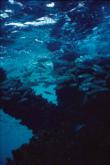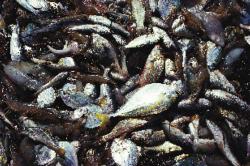Kingfish power play
Beat the kingfish at its own game, use a bait that bites back
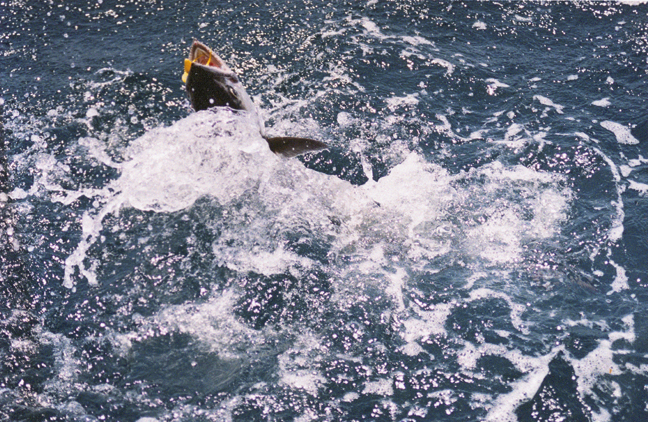
Tournament kingfishing can be a major head game, and if you don’t have your head in the game, you’re out of luck. Sure, one lucky pass over the right spot can put a big check in your hand. But consistently locating, enticing and boating smoker kings requires in-depth analysis and expert execution.
Forget that “elephants eat peanuts” cliche – we’re not fishing for pachyderms. When hefty kingfish top your target list, big baits equal big fish. Kingfish are primarily sight feeders, so larger targets get hit first. Eye-catching skirts in blue/white, chartreuse and red patterns often help draw attention to your baits in low-visibility conditions. Sliding onto the leader wire, these “dusters” pulsate in the water and reflect sunlight for maximum enticement.
Bait choices vary regionally from yellowtail snapper, rainbow runners and goggle eyes in South Florida, to menhaden (aka “shad” or “pogies”), mullet and bluefish off the Eastern Seaboard to Spanish 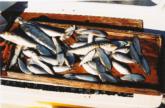 sardines, blue runners, cigar minnows and white trout in the Gulf of Mexico. In shallow beach or inlet waters, use an 8- to 10-foot castnet with 1 1/4- to 1 1/2-inch stretched mesh. In deeper channels and offshore spots, snare your baits with gold-hook (sabiki) rigs.
sardines, blue runners, cigar minnows and white trout in the Gulf of Mexico. In shallow beach or inlet waters, use an 8- to 10-foot castnet with 1 1/4- to 1 1/2-inch stretched mesh. In deeper channels and offshore spots, snare your baits with gold-hook (sabiki) rigs.
If the bite is on, a variety of baits may work. But when in doubt, use indigenous forage species. And if you happen across a school of baitfish under attack from predators below, jig up a handful of baits on 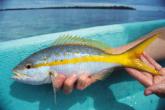 gold-hooks and immediately deploy them on stinger rigs. Fishing has few certainties, but feeding kings what they’re already eating is as close as it gets. (Troll freshly caught baits around the school’s perimeter and the outsiders won’t be long for this world.)
gold-hooks and immediately deploy them on stinger rigs. Fishing has few certainties, but feeding kings what they’re already eating is as close as it gets. (Troll freshly caught baits around the school’s perimeter and the outsiders won’t be long for this world.)
A standard weapon for many tournament anglers is the Atlantic cutlassfish, more commonly called “ribbonfish” or “silver eel.” Caught mostly at night on hook-and-line, these long, shiny targets grab lots of attention when fished deep on downriggers. Undulating in the water column, ribbonfish typically intimidate juvenile “schoolie” fish, so when this bait gets hit, it’s almost always a smoker king.
Wire wisdom
Undeniably, the most significant development in the sport of king mackerel fishing was the technique of live-bait slow trolling. Popularized decades ago by North Carolina’s kingfish fleet, this angling style hinges on the stinger rig – a tackle arrangement designed to beat the kingfish at its own game.
All members of the mackerel clan feed by hitting their prey at top speed, slicing it in half to immobilize the meal and then gobbling whatever pieces they missed on subsequent passes. Known as “short strikes,” these hit-and-run attacks prove positively perplexing when anglers rig live baitfish on single hooks.
Stinger rigs eliminate this frustration by placing a hook at both ends of a baitfish. Essentially, a No. 4 or No. 6 treble dangles from a piece of copper wire attached to a lead hook (usually a 2/0-3/0 short-shank model). Haywire twists and four or five barrel wraps connect wire and hooks.
Anglers can attach their trailing segments from the eye of a lead hook or from its bend. With the latter configuration, connect the open end of the stinger segment’s wire to one end of a barrel swivel and slip the swivel’s other end over the lead hook’s point and slide it onto the bend. This allows maximum range of motion.
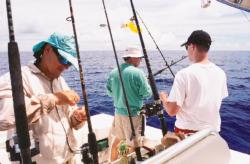 The lead hook primarily serves to connect baitfish and rig, while the trailing “stinger” hook does most of the grabbing. Occasionally, a lead hook ends up in the fish’s mouth and the stinger grabs the cheek, forehead or the nearest point of flesh. Kingfish have delicate mouths with no lips, so they often shake the lead hook, but remain ensnared by the stinger.
The lead hook primarily serves to connect baitfish and rig, while the trailing “stinger” hook does most of the grabbing. Occasionally, a lead hook ends up in the fish’s mouth and the stinger grabs the cheek, forehead or the nearest point of flesh. Kingfish have delicate mouths with no lips, so they often shake the lead hook, but remain ensnared by the stinger.
From a presentation standpoint, angling techniques can affect stinger performance. Stationary fishing (anchored, or from a pier or bridge) allows fish more time to inspect a bait, whereas trolling forces predators to commit on the run. If you use stingers for stationary fishing, scale down in your wire and hook size to minimize tackle visibility.
In the absence of stinger rigs, kingfish anglers typically use 30- to 40-pound fluorocarbon leaders and long-shank hooks. Setting the point of one long-shank hook through the eye of a second (facing the opposite direction) provides some level of short-strike prevention. However, the stinger rig’s superiority lies in the trailing hook’s mobility and its greater number of barbs. The double-hook rig does the job when giant kings inhale the entire bait, but stingers prevail more often on short strikes.
Now, some feel that inserting one point of a trailing hook into the bait’s skin is best because it keeps the stinger segment in place. Others believe this added point of stress wears down the bait too quickly and impedes its natural appearance. Generally speaking, the latter is true for fragile baits like threadfin herring, pilchards and Spanish sardines. Tougher baitfish such as cigar minnows and hardy blue runners can troll double-hooked for several hours without missing a step.
Either way, set the lead hook through the cartilaginous ridge between the bait’s snout and its eyes. With sturdy baits like runners, some opt for setting the lead hook through the skin on top of the bait’s head.
One exception is the lanky ribbonfish. With tournament ribbons measuring 18- to 24- inches, you’ll need a specialized rig for these high-visibility baits. Fished dead, ribbonfish require a 1/4-ounce jig under their jaws to troll straight and three or more stinger segments – as many as you need to cover the bait’s length.
Just as a shrimp cocktail or French onion soup ignites the appetites of restaurant patrons, various scents and edible morsels will drive kingfish into the food mood. That may mean drawing fish in from a distance or firing up those nearby. Regardless, techniques such as frozen chum blocks melting in the current, menhaden oil dripping from the transom and freshly chopped baitfish bear noticeable impact.
When several boats fish the same spot, combined chumming creates one massive scent trail, so you can often save your chum and just fish the seasoned waters. If you do chum, watch your positioning. Working too far uptide of the spot only chums up the fish for your opponents.
In some cases, chumming is unnecessary and actually ill advised. For example, around the drilling rigs off the Northern Gulf Coast, the slightest bit of appetizers will call in the sea’s most obnoxious and bothersome dinner guests – namely jack crevalle, barracudas and sharks. These indiscriminate diners will waste baits, rigs and precious tournament time, so withhold the invitation.
Elsewhere, when situations merit chumming, don’t overdo it with the freebies. Excessive chunking or tossing whole baitfish overboard allows the opportunistic kings to fill their bellies and shun hooked baitfish.
The exception is a “chum bomb” or “livewell dump.” In a move usually reserved for the last hour of tournament competition, anglers will drop a large, concentrated quantity of chum in hopes of stimulating a quick bite. The standard bomb is made of ground baitfish, menhaden oil, dry catfood, oats and sand. The latter ingredient carries the mixture through the water column where the oil floats topside as the solid pieces disperse their scent throughout the depths.
Cover the water
Kingfish feed where they find food. That said, the bite could occur anywhere from the surface to the sand. Until you pinpoint the strike zone, cover the water column with a spread of surface and “deep” baits.
Start by dropping at least one bait on a downrigger set to run just a few feet off the bottom. If you run a second downrigger bait, set this one farther behind the boat and position it at the mid-depth. Monitor your bottom contour, as well as fish concentrations and adjust downrigger depths to drag baits through the right areas.
Next, deploy two flat line baits at staggered distances. Run another bait at least 30 feet past your longer flat line and place this rod in an elevated holder. Set a large bait just 10 feet from the transom in the prop wash. Keep fresh bodies rotated into the spread and try mixing various bait species at different positions, depths and distances until you find the winning combination.
No doubt, kingfishing comprises a multiplicity of options and adjustments. The details can become overwhelming, but experience bears the clearest clues to effectiveness. Define what works for you, record pertinent details (tides, water temperature, depth, etc.) and look for points of refinement. Becoming a student of the game puts you in position to capitalize when the big one decides to eat.
Gaffing tips
A major point of contention among kingfish anglers is where to gaff the fish. Some aim for the head and hope that a quick kill hastens the capture. Others say gaffing the tail end pulls the fish’s motor out of the water and neutralizes its propulsion.
A good compromise spot lies between the primary (folding) and secondary (rigid) dorsal fins. The thick, meaty “shoulder” area makes a broad target.
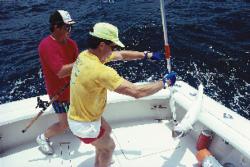 Most agree that a no-no for tournament anglers is gut gaffing. Sticking the fish below the lateral line runs the risk of puncturing the gastric cavity and that means a lot of bleeding. Not only does that soil your deck, but it can prove costly in the competitive arena. Ounces often determine kingfish tournament winners, and a few drops on the deck could literally cost big bucks.
Most agree that a no-no for tournament anglers is gut gaffing. Sticking the fish below the lateral line runs the risk of puncturing the gastric cavity and that means a lot of bleeding. Not only does that soil your deck, but it can prove costly in the competitive arena. Ounces often determine kingfish tournament winners, and a few drops on the deck could literally cost big bucks.
Also, avoid gaffing the part you plan to eat. In reality, gaffs don’t render fish inedible (unless rust becomes an issue). It’s more of an appearance thing – serving a kingfish filet that looks like it had an earring is somewhat of a culinary faux pas.
Wherever you aim, don’t let the drama of the moment spur you into error. Impatience begets sloppiness, which begets poor performance, which begets a lost fish. Wait for your moment and move with controlled confidence.
Kingfish end their battles with ascending circles at boat side. Work in concert with the angler and stay close, but out of the way until the fish reaches the surface. When you see skin, simply lay the gaff across the fish and smoothly pull it inward.
Some things to avoid: Don’t jab the gaff below the surface. Also, avoid “tickling” the fish by letting any part of the gaff touch it before you’re ready to make the grab.
Furthermore, never reach in front of the line. If the kingfish makes a desperation burst, the gaff could break the line. Always reach from behind whichever direction the fish is heading.
When you successfully stick the fish, swing it directly into the cooler, clip the leader, shake the gaff loose and close the lid. Remember, those dagger-like teeth work just as well out of the water as they do in the water.
